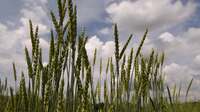Dancing spikes and fascinating anthers A short time travel through the wheat florets
Hybrid wheat production
Plant Architecture
First of all, we should clarify the most important terms.
Wheat spike
Spikelet
Floret
Fascinating anthers
Dancing spikes
Crossing
Hybrid production of wheat requires two things: the availability of mature pollen and receptive female lines. In the absence of their own pollen, the females need pollen from other plants in order to be fertilized and thus form grains. If successful pollination does not occur, the plant's own reproduction fails.
State of research
IPK Leibniz Institute
Text
Constanze Schmidt
Christian Schafmeister
Time-lapse photography
Constanze Schmidt
Videos | Photos | Grafic
Andreas Bähring
Constanze Schmidt
© 2022


























 Dancing spikes and fascinating anthers
Dancing spikes and fascinating anthers
 Hybrid wheat production
Hybrid wheat production
 Plant Architecture
Plant Architecture
 First of all, we should clarify the most important terms.
First of all, we should clarify the most important terms.
 Wheat spike
Wheat spike
 Spikelet
Spikelet
 Floret
Floret
 Fascinating anthers
Fascinating anthers
 Dancing spikes
Dancing spikes
 Crossing
Crossing
 State of research
State of research

